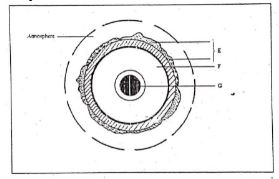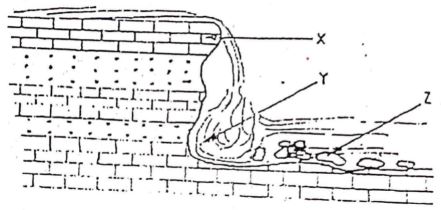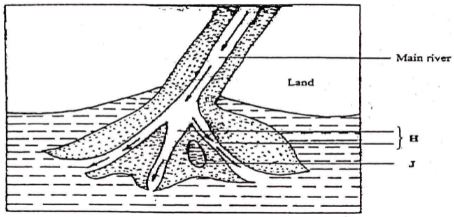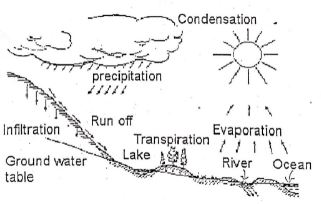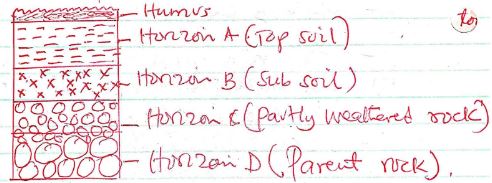GEOGRAPHY
PAPER 1
Instructions
- The paper contains 2 sections A and B.
- Attempt all questions in section A.
- In section B answer questions 6 and choose any other two questions.

Questions
SECTION A
-
- Other than the sun name this other heavenly bodies that make up the solar system.(1mks)
- The diagram below represent the structure of the earth. Use it to answer questions below
Name the layers marked E,F and G.
-
- State two characteristics of intrusive igneous rocks. (2mks)
- Fill the table below. (3mks)
Original Rock Metamorphic Rock Granite X Coal Y Z Marble
-
- What is folding? (2mks)
- Name three orogenies know in geological history. (3mks)
-
- State three factors which influence how rivers transport their load. (3mks)
- State three ways in which waterfalls may be formed. (3mks)
-
- Differentiate between ice sheet and ice berg. (2mks)
- Give two ways in which ice moves. (2mks)
SECTION B
Answer question 6 and any other two questions from this section.
- Study the map of Yimbo 1:50,000(sheet 115/1)provided and answer the following questions.
-
- Convert the representative scale give on the into statement scale. (2mks)
- Give the latitudinal extent of the area covered by the map. (1mk)
- Give the magnetic declination as at January 1965. (1mk)
-
- What is the height of usire hill? (1mk)
- What is the length in kilometer of all weathered road loose surface (C506) from the road junction at grid square 3082 to the eastern edge of the map? (2mks)
- What is the bearing of the air photo principal point on grid reference 3274 from the trigonometrical station on grid reference 3980? (2mks)
- Using a scale 1cm to represent 100m draw a cross section along northing 99 between easting 16 and 22. (4mks)
On the cross section mark and name the following- Steep slope (1mk)
- A seasonal river (1mk)
- Thicket vegetation. (1mk)
(Answer on the graph paper)
-
- Explain three physical factors that have influenced the distribution of settlements in the area covered by the map. (6mks)
- Calculate the vertical exaggeration of the cross section.drawn. (2mks)
-
-
-
- Describe the following characteristics of minerals.
Texture. (1mk)
Tenacity. (1mks)
Colour. (1mk) - Describe how extrusive igeneous rocks are formed. (5mks)
- Describe the following characteristics of minerals.
- State three characteristics of rock. (3mks)
- Explain three economic significance of rocks in Kenya. (6mks)
- Student carries out field study on rocks around their school.
- State two importance of stating the objectives of the study. (2mks)
- Give three reason why they prepare a route map for the study area. (3mks)
- Give three activities that the students were involved in during the field study. (3mks)
-
-
-
- What is vegetation. (2mks)
- Distinguish between natural and derived vegetation. (2mks)
- The map below shows the world vegetation regions. Study and use it to answer the questions that follow.
- Identify grassland regions marked 1,3 and 5. (3mks)
- Describe the characteristics of vegetation marked X. (5mks)
- Explain how the following factors influence growth and distribution of vegetation .
- Altitude. (2mks)
- Soils. (2mks)
- Human activities. (2mks)
- You class is to undertake a field study an vegetation in the man forest.
- State two objectives of the study. (2mks)
- Prepare a working schedule for the study. (5mks)
-
-
-
- Using a well labeled diagram, show the main processes of the hydrological cycle. (5mks)
- Differentiate between watershed and a catchment area. (2mks)
-
- The diagram below shows a waterfall.name the features marked X,Y,Z. (3mks)
- State three ways in which a waterfall may form. (3mks)
- The diagram below shows a type of a delta .Use it to answer the question below
- Name the type of the delta shown above
- Identify the features feature marked H and J delta.
- Describe the formation of the above delta. (3mks)
- The diagram below shows a waterfall.name the features marked X,Y,Z. (3mks)
-
-
-
- Define the term soil. (2mks)
- State four composition of soil. (4mks)
-
- Differentiate between soil profile and soil catena. (2mks)
- Draw and label the diagram to show soil profile. (5mks)
- What are the impacts of soil erosion. (5mks)
- You are required to carry out a field study on the lower course a river
- Give two reasons why you would require a route map. (3mks)
- State two activities you would carry out to setermine why deposition occurs at this stage. (2mks)
- State three follow up activities you would be involved in after the field study. (2mks)
- Students from a school in nakuru county are planning to carry out a field study on soil.
- Give three reasons why it is important to seek permission from the school authority. (3mks)
- identify four challenges you would encounter during field study. (4mks)
-

Marking Scheme
-
-
- Eight planets
- Satellites(moons)
- Asteroids
- Comets
-
- E-Crust
- F-Mantle
- G-Inner core
-
-
-
- They are formed below the earth crust.
- They have large crystals.
- They occur in large masses.
-
Original Rock Metamorphic Rock Granite Gneiss Coal Graphite Limestone Marble
-
-
- Folding is a process of crustal distortion which causes the rocks to bend upwards or downwards.
-
- Chanian orogeny
- Caleridonian orogeny
- Hercynian orogeny
- Alphine orogeny.(Any 3×1=3mks)
- Folding is a process of crustal distortion which causes the rocks to bend upwards or downwards.
-
-
- Size of the individual rock particle.
- Gradient of river channel.
- Amount of water in the stream.
- Amount of load.
-
- Where a river descends on a resistant rock layer which is either vertical, horizontal or inclined.
- When a river descend on a sharp edge of a plateau.
- Where a river falls over a fault scarp.
- Where a river descends through a cliff into the sea.
- Where a river descends from a hanging valley into a glacial trough.
(Any 3×1=3mks)
-
-
- Ice sheet is a large and continous mass of ice which covers large areas of lowland, while ice berg is large mass of ice which have broken off from the ice sheet and is partially submerged in water.
-
- Plastic flowage.
- Basal slip.
- Extrusion flow.
- Internal shearing.
- Ice sheet is a large and continous mass of ice which covers large areas of lowland, while ice berg is large mass of ice which have broken off from the ice sheet and is partially submerged in water.
-
-
- 1:50,000
50,000/100=500m
500/1000=0.5km
One centimeter represent zero point five kilometer or 1cm rep 0.5km - 0ᵒ0’s to 0ᵒ15’s
- 2ᵒ28’
- 1:50,000
-
- 1280m
- 10.3±1km
- 230ᵒ±1
4
- 1280m
-
-
- Relief
- There are no settlement on hilly places.
- There is dens settlement on the gentle slopes because it is easy to put up settlement and carry agriculture.
- There is no settlement on the river valley due to fear of flooding.
Vegetation - There is no settlement in the area with thick vegetation due to attack of pests.
- There is no settlement in the area covered by papyrus swamp/vegetation because the area is water is water logged.
Drainage - There is inucleated settlement along some rivers for instance Alara Yenga.
-
- V.E=V.S
H.S
1 ÷ 1
20 50,000
1 × 50,000
20 1
=2.5
2.5 times
- V.E=V.S
- Relief
-
-
-
- Texture
This is the degree of resistance some mineral have high resistance while others are soft.
Tenacity. (1mks)
This is the ability of a mineral to withstand tearing crushing or breaking it differs.
Colour. (1mk)
Minerals have specific colours example gold yellow and copper-brown. -
- During volcanic eruptions lava are thrown on the earth surface.
- The lava cools and solidifies to form igneous rock the rate of cooling and solidification is very rapid.
- This happen because of low temperature.
- Texture
-
- Crystalline in structure.
- Glassy in appearance.
- Cools and solidify in the earth crust or on the surface.
-
- Form unique scenaries which attract tourist- foreign exchange is earned.
- Provide parent rock for formation of soil for Agriculture.
- Impermeable rocks may store water which can be tapped to supply water for domestic and industries.
-
-
- It describes the actual detail that the researcher intend to look for during the study.
- It gives the direction to the study the goal.
-
- To help identify direction to follow.
- To help prepare a work schedule.
- Help identify the location of feature.
- Help estimate distance to be covered.
-
- Collecting the samples of rocks.
- Observation of the rocks.
- Breaking the rock to obtain samples.
-
-
-
-
- Vegetation is a community of plants is a community of plants such as shrubs, trees herbs and grass that cover a place and give its distinct character.
- Natural vegetation –it is a type of vegetation develops without interference and modification of human activities while derived vegetation which is in the process of revolving from mans disturbance.
-
-
- 1-Steppe
- 3-Pampas
- 3-Veld
-
- Forests are conical in shape.
- They have needle shaped leaves.
- The tree are found in uniform stands.
- Are common in high altitude.
- Contain a thick carpet of mosses.
- The species are generally few.
-
-
- Altitude. (2mks)
Altitude affect the temperature and rainfall that in turn affect vegetation - Soils. (2mks)
The texture of the soil determine the relative ease with which roots can penetrate into the soil- affect the nutrient ability of the soil. - Human activities. (2mks)
Human activities like clearing and cultivation overgrazing and pollution affect vegetation.
- Altitude. (2mks)
-
-
- To find the tree species found in the forect
- To find out the causes of destruction of the forests.
-
Time Activities 8:00-8:30a.m Meet in the Assembly 8:30-9:00a.m Travel to the forest 9:00-9:30a.m Collection of data 11:30-1:00p.m Taking lunch 1:00-1:40p.m Travel back to school
-
-
-
-
-
- A watershed is a ridge line or boundary line separating drainage or river system or basin while catchment area is an area or land form which a river or a reservoir draws its water or source of rivers.
-
-
-
- X-Resistant rock/sill/cup rock
- Y-Plunge pool
- Z-Rock boulder
-
- When a river enters into a valley through an escarpment.
- When a river plunges into the lower coastal land from a plateau.
- When a landscape blocks a river forming a barrier lake.
-
-
- Birds foot delta
-
- H-Distributaries
- J-Lagoon/lake
- This types of delta generally forms on rivers carrying large quantities of fine alluvium into water where there is low wave energy.
The delta has very few distributaries and ones present form for a pattern resembling a foot of a bird.
-
-
-
- Soil is a layer of the earth on which plants grow.
-
- Inorganic matter (minerals)
- Organic matter(humus)
- Soil water
- Soil air
-
- Soil profile is a vertical arrangement of various soil in layers while soil catena is the arrangement of soil on mountain slopes from top to bottom.
-
-
- Soil erosion leads to loss of production top soil making land bare.
- Leads to discharge of Agro-chemical into rivers.
-
-
- To help identify the direction to follow.
- To help prepare a work schedule.
- To help identify the location of features for study.
- To help estimate the time the field study is likely to take.
-
- Measuring of the gradient.
- Finding out the nature of the load.
- Establishing the velocity of the river.
- Observing obstacles in the stream channel or distributaries.
- Measuring of the width or dept of the river.
-
- Discussion on the finding with the rest of the class.
- Write report of the data collected.
- Display photographs or items collected.
- Draw diagrams, charts, or tables to present the information obtained.
- Model the flood plain.
- It blocks river channels leads to flooding.
- It creates fertile soils in the low land area.
- Leads to deposition of sand in river beds which are harvested for building.
- Leads to siltation of water reservoirs reduce the H.E.P production and irrigation.
-
-
-
- Form official requirement
- To enable administration arrange for transport
- To enable administration provide essential tools
- To enable administration to take care of and disruption in the school programmes.
-
- Attack by wild animals, snake.
- Harsh weather condition like high temperature.
- Fatigue due to walking for long distances.
- Inadequate time for data collection.
- Rugged therein makes movement difficult.
-
-
Download Geography Paper 1 Questions and Answers - Form 4 Opener Term 1 Exams 2022.
Tap Here to Download for 50/-
Get on WhatsApp for 50/-
Why download?
- ✔ To read offline at any time.
- ✔ To Print at your convenience
- ✔ Share Easily with Friends / Students

